
Michelangelo Merisi da Caravaggio, known mononymously as Caravaggio, was an Italian painter active in Rome for most of his artistic life. During the final four years of his life he moved between Naples, Malta, and Sicily until his death. His paintings have been characterized by art critics as combining a realistic observation of the human state, both physical and emotional, with a dramatic use of lighting, which had a formative influence on Baroque painting.

Guido Reni was an Italian painter of the Baroque period, although his works showed a classical manner, similar to Simon Vouet, Nicolas Poussin, and Philippe de Champaigne. He painted primarily religious works, but also mythological and allegorical subjects. Active in Rome, Naples, and his native Bologna, he became the dominant figure in the Bolognese School that emerged under the influence of the Carracci.

Mercy is benevolence, forgiveness, and kindness in a variety of ethical, religious, social, and legal contexts.

A "Doom painting" or "Doom" is a traditional English term for a wall-painting of the Last Judgment in a medieval church. This is the moment in Christian eschatology when Christ judges souls to send them to either Heaven or Hell.

The Madonna and Child with St. Anne or Madonna and the Serpent, is one of the mature religious works of the Italian Baroque master Caravaggio, painted in 1605–1606, for the altar of the Archconfraternity of the Papal Grooms in the Basilica of Saint Peter and taking its theme from Genesis 3:15. The painting was briefly exhibited in the parish church for the Vatican, Sant'Anna dei Palafrenieri, before its removal, due to its unorthodox portrayal of the Virgin Mary. There are a lot of reasons why the piece may have been removed, such as the nudity of the child Jesus and the Virgin Mary revealing too much of her breast. The reputation of the model that Caravaggio used to portray the Virgin Mary could be another reason as to why this altarpiece was withdrawn. The altarpiece was sold to Cardinal Scipione Borghese and now hangs in his palazzo.
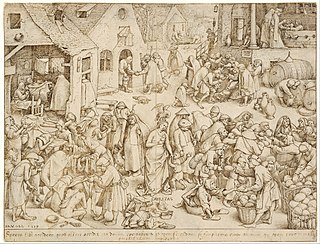
Works of mercy are practices considered meritorious in Christian ethics.

The Madonna of the Rosary is a painting finished in 1607 by the Italian Baroque painter Caravaggio, now in the Kunsthistorisches Museum in Vienna. It is the only painting by Caravaggio that could be called a standard Baroque altarpiece.

The Flagellation of Christ is a painting by the Italian Baroque painter Caravaggio, now in the Museo Nazionale di Capodimonte, Naples. It is dated to 1607, and may have been reworked by the artist in 1610. It is not to be confused with Christ at the Column, another Flagellation by Caravaggio of the same period.

Giovanni Battista Caracciolo (1578–1635) was an Italian artist and important Neapolitan follower of Caravaggio. He was a member of the murderous Cabal of Naples, with Belisario Corenzio and Giambattista Caracciolo, who were rumoured to have poisoned and disappeared their competition for painting contracts.
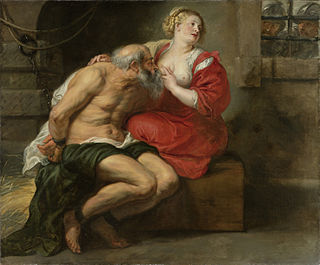
Roman Charity or Cimon and Pero is an ancient Greek and Roman exemplary story of filial piety in which a woman secretly breastfeeds her father or mother, incarcerated and supposedly sentenced to death by starvation. Once caught, the loving devotion shown so moves the authorities that she is forgiven and the parent is typically freed. The father in the story is often named Cimon and the daughter Pero, although other versions name the father Mycon. First attested in surviving Roman sources, it became a common theme in Early Modern period of Western European art, particularly the Baroque period.
General judgment is the Christian theological concept of a judgment of the dead. When the individual dies, general judgment holds that the person's final dispensation will await the general judgment of the dead at the end of the world, rather than be judged immediately. It is generally contrasted with a particular judgment right after death. It is related closely to Judgment Day and often is just another phrase for the Last Judgment or Final Judgement.
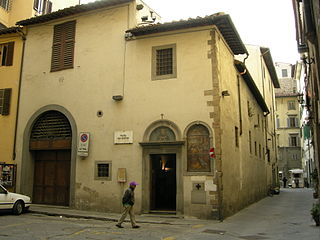
San Martino del Vescovo, also known as the Oratorio dei Buonomini di San Martino, is a Roman Catholic parish church, located in the small piazza of the same name in Florence, Italy.
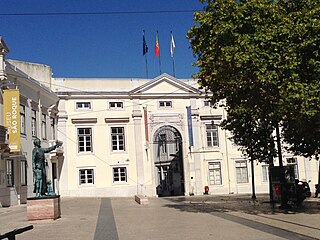
Santa Casa da Misericórdia is a lay Portuguese charity founded in 1498, whose mission is to treat and support the sick, the disabled, as well as abandoned newborns.

The Virgin of Mercy is a subject in Christian art, showing a group of people sheltering for protection under the outspread cloak, or pallium, of the Virgin Mary. It was especially popular in Italy from the 13th to 16th centuries, often as a specialised form of votive portrait; it is also found in other countries and later art, especially Spain and Latin America.

The Pio Monte della Misericordia is a church in the historic center of Naples, southern Italy. It is famous for its art works, including Caravaggio's The Seven Works of Mercy. A charity brotherhood was founded in August 1601 by seven young nobles, who met every Friday at the Hospital for Incurables and ministered to the sick.

Louis Finson, Lodewijk Finson or Ludovicus Finsonius was a Flemish painter, draughtsman, copyist and art dealer. He painted portraits, religious compositions, allegorical paintings and genre scenes. Moving to Italy early in his career, he became one of the first Flemish followers of Caravaggio whom he knew personally in Naples. He produced a number of copies after works by Caravaggio. He worked for a number of years in various cities in France where he created altarpieces and portraits. He is known for being the co-owner together with his fellow Flemish painter and business partner Abraham Vinck of two paintings by Caravaggio. Louis Finson played a major role in the Northern Caravaggesque movement through his own works as well as his role as an art dealer.
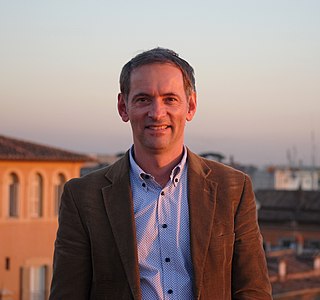
Ralf van Bühren is a German art historian, architectural historian, church historian, and theologian. He is professor of art history at the School of Church Communications at the Pontifical University of Santa Croce in Rome, and also lecturing at the Pontificia Università Gregoriana. His courses on Sacred Art and Architecture in Rome are open to students of US universities with campus in Rome.
Giovanni Vincenzo Forli was an Italian painter of the Baroque period, active in Naples.

The Extraordinary Jubilee of Mercy was a Catholic period of prayer held from 8 December 2015, the Solemnity of the Immaculate Conception, to 20 November 2016, the Feast of Christ the King. Like previous jubilees, it was seen by the Church as a period for remission of sins and universal pardon focusing particularly on God's forgiveness and mercy. It was an extraordinary Jubilee because it had not been predetermined long before; ordinary jubilees are usually celebrated every 25 years.
The Seven Works of Mercy is a 1504 oil on panel painting by the Master of Alkmaar, consisting of seven panels, each showing one of the works of mercy.

















